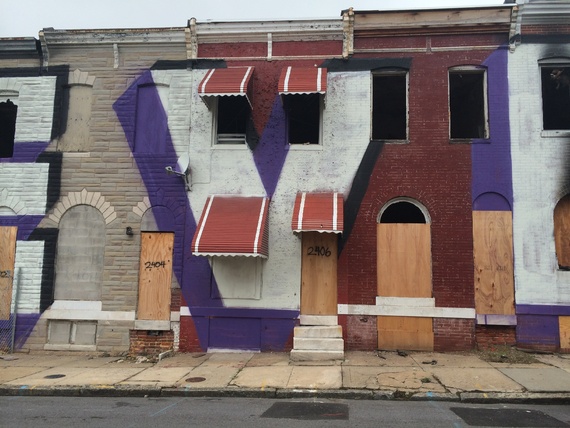Can Homeless People Move Into Baltimore’s Abandoned Houses?

Jeremiah, who is 28 and used to work in landscaping, didn’t have anywhere to live during the frigid cold of last winter. So one night, when the shelters of Baltimore were full, he ducked into an alley near downtown Baltimore, where an abandoned house had a “For Sale” sign on it. The back door was open, so he let himself in and went to sleep.
There was gas and electricity but no water, and he kept the lights off so no one would see he was living there. And no one seemed to mind. So he came back the next night and then the next, using the home to keep warm until spring came, although he’d turn off the gas at night since he was worried about leaks.
“They need to fix up these homes that we have here,” he said, sitting under a highway bridge in downtown Baltimore, a navy blue hooded sweatshirt snugly covering his head. He now sleeps in a tent under the bridge, alongside dozens of other homeless people, some in wheelchairs, others who have come draggingmattresses or couches upon which to lay their heads. Loitering in a vacant home in Baltimore can get you arrested, and though he misses the warmth, Jeremiah didn’t want to take the chance, so he moved out of his adopted home when the weather got warmer.
But one group in Baltimore is pushing to help others do officially what Jeremiah did on the fly: take vacant homes and turn them into permanent affordable housing for the homeless. Housing Our Neighbors, part of the Housing Is A Human Right Roundtable, is made up of labor activists, homeowners, and homeless people. The group is currently surveying the McElderry Park neighborhood in Baltimore in order to present the city with a report on the number of vacant homes there. They say the data will show there are far more vacant homes in Baltimore than the city has previously acknowledged, and they argue that those homes should be turned into affordable housing.
“Clearly there’s a moral crisis when you see so many people in need of homes and there’s such a glut of vacant ones,” said Rachel Kutler, a leadership organizer with United Workers, which works with the Roundtable.
I went along with Tony Simmons, who is homeless, on a tour through a neighborhood the group recently surveyed. Simmons, 53, is wiry and energetic, and talks constantly about vacant homes, the project, and his own history. He served in Operation Desert Storm, after which he spent some time as a drug runner, driving cars filled with drugs between cities on the Eastern Seaboard, partially so he could fund the heroin habit that was taking over his life. Now, though he’s kicked his habit and has thrown himself into activism for the homeless, although he doesn’t yet have his own home.
We start at the church where the group meets before it begins its surveys, and walk down an alley where vacant homes have been turned into a community garden. Crossing a busy street, Simmons points out a deflated helium balloon tied around a telephone pole alongside a photo of a smiling teenager marking a spot where someone had been shot and killed.
Some of the homes we pass seem almost new, others are sagging, their paint peeling. Simmons has an eye for which ones are too far gone to save, and which are uninhabited, even if they don’t have plywood on their windows and doors.
“This house is perfect—the windows are intact, the doors are intact, the foundation is strong and there’s no leaking in the basement,” Simmons says, in front of one home, with gray and tan bricks on its facade and a bright plywood board on the door. “Yet it’s all boarded-up.”
There are more than 16,000 vacant homes in Baltimore, according to the city. About 30,000 people in the city will experience homelessness over the course of the year, 3,000 on any given night. That’s partially because Maryland, one of the richest states in the union, has some of the least affordable housing in the country. A minimum-wage worker in Maryland would have to work 138 hours a week to afford a two-bedroom unit at fair-market rent, according to the National Low-Income Housing Coalition.
As more central parts of Baltimore get trendier, housing there is expected to geteven more expensive. Earlier this year, Baltimore put forth a plan that would sell 40 percent of the city’s affordable-housing stock to private developers so they could rehab it, a move that advocates worry could exacerbate the housing shortage extremely low-income people face. In a report this spring, the Urban Institute estimated there were 29 affordable units for every 100 extremely low-income households in Baltimore.
Even in the gutted streets of McElderry Park, where drug dealers still sell on some corners, Simmons and others have noticed green signs posted on the buildings lately. “For Sale: Finished, The Homes at Griffon Station,” they say, even though they are posted on plywood-covered doors and burnt out houses. Simmons says he suspects the signs are related to nearby John Hopkins University, which is constantly expanding its footprint in the city.
Baltimore closed the waiting list for Section 8 Housing vouchers eleven years ago, though it’s purging the list and re-opening it this year. Adam Schneider, of the Baltimore group Health Care for the Homeless, estimates there are 25,000 people in homes through the Section 8 program, and 25,000 more who need the vouchers. It’s not just Baltimore: There are 7 million fewer affordable housing units than are needed in the country, said Nan Roman, the president of the National Alliance to End Homelessness.
“Most people are homeless largely for economic reasons,” she said. “If there’s not enough affordable housing, people who have additional barriers are not going to be competitive in the market and they’re going to lose out.”
That’s why the roundtable wants to turn the vacants of Baltimore into affordable housing. Its goal is to create a community land trust—a non-profit that will hold the title to the land in order to make it permanently affordable. Structures on the land can be bought and sold, but the trust owns the land forever. A community land trust essentially takes the “market” part out of the housing market, allowing people to buy homes but restricting their resale value in order to make them affordable for the next buyer.
It’s an approach that’s worked to protect low-income residents from gentrification in places like Austin, Texas; Albany, Georgia; and Albuquerque, New Mexico.
“We know that part of what’s created vast inequalities in society has to do with the for-profit housing system,” Kutler says. “If we just create more market-rate housing out of the vacants, it just sort of defeats the purpose.”
People who currently live in the neighborhood don’t seem concerned about the idea that they could soon have homeless people as neighbors; that could be because people are often squatting in the houses anyway. Shemeika James and her brother Darryl Owens just moved to a row house in the neighborhood. When I asked if they’d mind if a group fixed up the houses and put homeless people in them, they didn’t even pause. They’d welcome it, they said.
“There’s a lot of people without homes, and it’s about to get cold. There’s hella homeless people living downtown,” James said. “It’s not right.”
Another neighbor, Deborah Barry, said she had been independently talking with her landlord about turning some of his vacant properties into a shelter. It’s the only way people will be able to move into them, she said.
“They just want too much for homes in this neighborhood,” she said. “It’s not affordable.”
There are obvious problems with taking over privately owned properties and giving them to the needy. But the homes aren’t being used, and they’re dragging down the home values of the occupied homes nearby, Simmons argues. And many are city-owned: Out of the 300 homes the Roundtable has surveyed, about 80 are owned by the city, property records show.
Cities like Baltimore and Philadelphia have had some success in targeting the owners of privately-owned vacants for code violations, forcing them to sell the houses at auction or donate them to the city. But those then often become unaffordable for low-income people: A program called Vacants to Value in Baltimore gives buyers $10,000 in assistance if they buy a formerly vacant home, but some of the homes cost much more than that. And buyers have to prove they have the resources to rehab a home in a year.
A few cities have had success with turning vacants into affordable housing. New York City spent $20 million to turn some stalled condo developments into housing for low- and middle-income residents. The Women’s Community Revitalization Project in Philadelphia has used land trusts to create affordable housing for low-income women. And a few cities have taken advantage of a law that allows vacant federal buildings to be turned into housing for the homeless.
Still, Kutler says, developers aren’t exactly excited about the idea of giving up housing stock for the people sleeping on the streets of Baltimore. Because the housing market in the city is weak, developers are more focused on gentrifying neighborhoods and preventing more abandonment from happening. But community land trusts don’t have to stand in the way of gentrification, Kutler says.
“Community land trusts and our permanently affordable housing efforts are actually a revitalization tool,” she says, pointing to cities like Minneapolis where neighborhoods have been gentrified in part because of land trusts.
At any rate, Simmons, Kutler, and others in the group are particularly saddened when homes are demolished. It seems such a waste when there are so many people forced onto the streets.
Simmons shows me one long block of row housing in McElderry Park where every single house is vacant and boarded-up. The city commissioned an artist to paint a mural on it, and now the 35 houses are covered in big letters in bright purple and white paint that spell out “Forever Together.”
He goes up to one across the street and fingers the plywood covering the door.
“Why can’t somebody live here? The house is perfectly intact,” he says, shaking his head. “Because it’s cheaper to let developers buy them out, that’s why.”
Additional Resources
 Can_Homeless_People_Move_Into_Baltimores_Abandoned_Houses-_The_Atlantic
Can_Homeless_People_Move_Into_Baltimores_Abandoned_Houses-_The_Atlantic
